Application of Wavelength Dispersive X-ray Fluorescence to Agricultural Disease Research
X-ray fluorescence (XRF) is a useful technique in agricultural science to determine the elemental constituents of plant materials. It allows for quick analysis, high spatial resolution, measurement of multiple elements within a single scan, and requires minimal sample preparation while being nondestructive. In this study, we used wavelength dispersive XRF (WDXRF) to study agricultural diseases. We performed a spectroscopic investigation in agricultural samples to measure the elemental changes caused by infestation. A broad range of major, trace, and heavy elements were detected and quantified in healthy and infested crop samples, and we observed significant changes in the elemental concentrations. We also used laser-induced breakdown spectroscopy (LIBS) in combination with XRF spectrometry. Further improvements will provide exciting perspectives for the application of XRF in the area of plant and agricultural science.
It has been observed that approximately 14 essential elements are needed for the proper growth and development of plants, along with water, hydrogen, oxygen, and carbon dioxide. These nutrient elements are further categorized as macronutrients and micronutrients. Macronutrients, such as calcium, magnesium, nitrogen, potassium, phosphorus, and sulfur, are needed by plants in large amounts (>1000 mg per kg dry weight), whereas micronutrients, including boron, chlorine, copper, iron, manganese, molybdenum, nickel, and zinc, are required by plants in small amounts (<100 mg per kg dry weight) (2). Even though plants require only small amounts of micronutrients, these nutrients are equally important for the proper growth and development of plants.
Trace element detection is important in plant science. The concentration of trace mineral elements in plants, as well as in the soil, can change, and this variability can lead to deficiencies or excess accumulation of these mineral metals (3). Knowledge of the concentrations of trace elements in plants is important for diagnosis of various agricultural crop diseases. Crop disease development depends on three main factors: a susceptible host plant; favorable environmental conditions; and the pathogen involved, sometimes displayed as a “disease triangle” (Figure 1). Environmental conditions, in particular, play a major role in the occurrence and the growth and development of plant diseases; many diseases will not emerge if environmental conditions, such as temperature, relative humidity, soil moisture, soil pH, rain, and water content, are not favorable.
FIGURE 1: Illustration of the plant disease triangle.
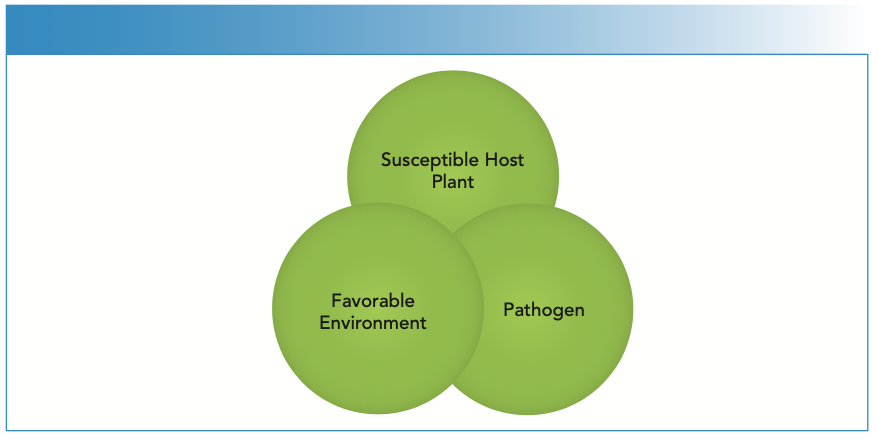
Atomic spectroscopy methods are the first choice for assessing the mineral composition of agricultural crop samples. For most atomic spectroscopic techniques, samples preparation is required, such as sample dissolution using a mixture of strong acids (generally nitric and sulfuric) and oxidants (commonly hydrogen peroxide). In many cases, it is easy to dissolve the samples in the solution. Because of the presence of silicon in plant samples, sample preparation usually requires a mechanisms that ensure complete decomposition, to ensure efficient dissolution of metallic elements into solution. Hydrofluoric acid addition, along with evaporation for achieving dryness, is needed to complete the proper dissolution of the analyte; otherwise, the presence of silicon may result in poor recoveries of some elements due to the binding of analytes with the insoluble residues (4).
Proposed methods found in the literature, from large numbers of acid mixtures used in wet washing procedures, reveal a lack of consensus for achieving the complete dissolution of plant specimens. The choice of decomposition method for a given plant sample material must be evaluated carefully, considering each of the matrices and analytes under study. In reviewing these challenges of sample digestion, analytical methods that do not require matrix destruction can be advantageous for such studies.
Nearly all X-ray fluorescence (XRF) techniques have desirable features for the analysis of plant samples. These features include the capability to carry out direct analysis of solid samples, multielemental analysis, the capability to carry out the qualitative analysis along with quantitative determination, a broad dynamic range, high throughput, and low maintenance and analysis cost. The major drawback of XRF is its limited sensitivity for elements like cadmium and lead. The poor precision and accuracy of XRF compared to other atomic absorption spectroscopic techniques is also a limitation. However, some recent improvements, such as the advancement of digital processing-based spectrometers, along with better detector designs in XRF instrumentation, have increased instrumental sensitivity and improved both the precision and productivity of XRF. These improvements have increased interest in adopting XRF spectroscopy in environmental science for analyzing various plant materials. The use of different quantification strategies employing distinct configurations of XRF instrumentation for the analysis of various vegetation matrices has been discussed.
Materials and Methods
Identification of Nematode Species in Okra and Papaya
We have collected healthy and nematode-infested okra root samples, which are shown in Figures 2a and 2b, from field sites of Uttar Pradesh, India. We have also collected nematode-infested and healthy papaya root samples, as depicted in Figure 2c. After collection, the samples were washed, and after drying the samples, they were milled into a fine powder for spectroscopic studies.
FIGURE 2: (a–d) Photographs of nematode-infected okra and papaya roots, and rice grains infected with false smut disease.

Cobb’s sieving and decanting methods were used to draw out the body parts of male, female, and juvenile nematodes to identify the species of nematodes in the diseased okra and papaya plant root samples. We adopted the procedure for species identification described by Goodey (1963) (5), and the species was identified on the basis of the characteristics observed in the perineal regions of the female nematodes by employing the method provided by Eisenback and others (1985) (6). Our examinations revealed that the species of root-knot nematode pathogens in the diseased okra and papaya roots was Meloidogyne incognita. Details regarding the sample preparation and identification of nematode species have been described by Sharma and others (7,8).
Collection and Isolation of Rice Samples (Healthy and Infected with False Smut)
A survey was conducted in rice fields suspected of false smut infestation in Uttar Pradesh, India, during the Kharib season of 2018–2020. Healthy rice grains and rice grains infested with false smut disease were collected (Figure 2d). The rice grain samples were carefully separated along with smutty balls from rice spikelets and milled into a fine powder form. The upper surface of smutty balls was sterilized by dipping them in a solution of 1% sodium hypochlorite for approximately 1 min and then cleaning with 70% ethanol solution for about 1 min. More details regarding the isolation of false smut disease pathogens from rice grains has been described by Sharma and others (9).
Study of Root-Knot Nematode–Infected Okra Plant Roots
In the present study, we employed wavelength dispersive X-ray fluorescence (WDXRF) spectroscopy to examine in healthy and nematode-diseased okra root samples. We detected many elements, such as aluminum, calcium, copper, chromium, chlorine, iron, manganese, magnesium, nickel, phosphorus, potassium, rubidium, sodium, silicon, strontium, sulfur, titanium, zinc, and zirconium. We noticed significant differences in the elemental composition of healthy and diseased samples. Figure 3 shows WDXRF spectra of healthy and nematode-infested okra roots in the energy range of 5–10 keV, which shows the relative abundance of the elements chromium, manganese, iron, nickel, zinc, and copper.
FIGURE 3: WDXRF spectra of healthy and nematode-infested okra roots in the energy range of 5–10 keV, which shows the relative abundance of the elements chromium, manganese, iron, nickel, zinc, and copper. Data were taken from reference (7).
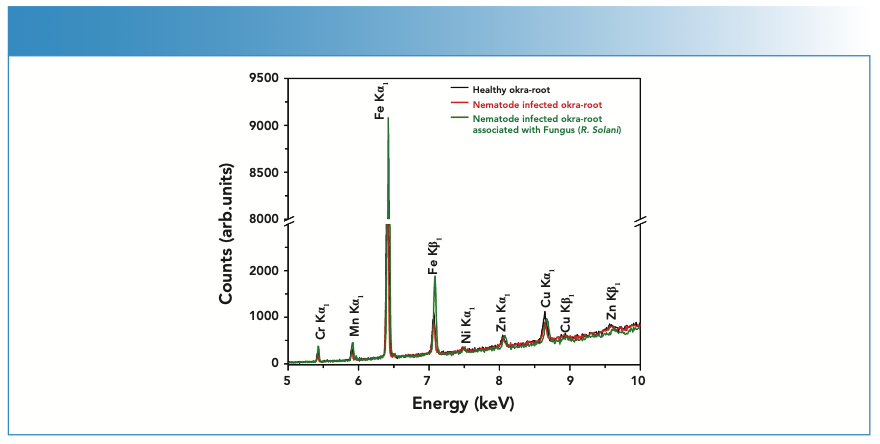
Several mineral elements—particularly calcium, chlorine, magnesium, potassium, sodium, and sulfur—were found to have higher concentrations in nematode-infested okra plant samples compared to healthy root samples. Other elements, including copper, phosphorus, manganese, silicon, and zinc, were found to be in lower concentrations in nematode-infected root samples as compared to healthy okra root samples. Some toxic elements, such as aluminum and chromium, were observed in lower concentrations in the infested root samples. No significant differences in the concentration of elements like bromine, rubidium, nickel, and zirconium were observed. Some traces of silver were found only in nematode-infected okra root samples, whereas traces of palladium were found only in nematode-infested root samples.
Our experimental findings were supported by the literature and other published reports. The observation of lower concentrations of iron, phosphorus, and zinc in nematode-infected okra root samples aligns with results reported by Farahat and others (10). Lower concentrations of iron, phosphorus, and zinc also have been observed in the diseased tissues of nematode-infected citrus, eggplant, jasmine, cowpea, and papaya plants (10). Sharma and others have also witnessed the decreasing concentration of phosphorus in nematode-infested okra root samples as compared to root samples from healthy okra plants (11). We also observed a higher concentration of sodium and a lower concentration of phosphorus in the nematode-infested okra root samples, which also aligns with results reported by Sharma and others (11).
Some nonessential elements, such as silver and palladium, were detected only in infected root samples, which indicates that their presence may be associated with the formation and development of nematodic pathogens on okra roots. Elements like strontium and titanium were also observed in increased concentrations in nematode-infested okra root samples. Heavy elements such as aluminum, chromium, and titanium were also observed in higher concentrations in nematode-diseased root samples of okra plants, and appears to be related to the formation of galls on the surface of roots with the invasion of pathogens. The higher concentration of aluminum can be considered a threat to agricultural crops because aluminum obstructs root growth and disturbs nutritional balance, encouraging the induction of oxidative stress. This stress leads to peroxidation reactions in the cytoplasmic membrane and ultimately leads to cell death (12). The physiological and biochemical functions of chromium in plants is not particularly clear (13). It has been observed that excessive levels of chromium can encourage several detrimental biochemical, morphological, and physiological effects on plant health (13,14). Nevertheless, the overall toxicity of chromium in plants is well documented (13). All these elemental changes are capable of posing serious and toxic effects in plants such as hindering growth mechanisms, disturbing photosynthesis, translocating mineral nutrients, disrupting the water intake capacity, and ultimately declining the overall quality of the okra plant.
Study of Root-Knot Nematode–Infected Papaya Plant Roots
We have also studied root-knot nematode-infected papaya plant root samples employing WDXRF to obtain the elemental variations between healthy and diseased papaya root samples. Using WDXRF, numerous elements, such as aluminum, chlorine, copper, chromium, calcium, magnesium, manganese, iron, potassium, sodium, phosphorus, nickel, silicon, rubidium, sulfur, and zinc were detected in root samples of healthy and diseased papaya plants (8). Figures 4a and 4b show the overlapping WDXRF spectra of healthy and diseased papaya root samples within different energy ranges, indicating the presence of elements such as aluminum, calcium, and potassium. The WDXRF spectra of papaya root samples showed that concentration of mineral elements changed with nematode infestation. It has been documented that the induction of antioxidants, creation of mechanical obstructions, and triggering of defense systems in plant bodies are all associated with good accessibility of mineral nutrients in plants (15). It was observed that the concentrations of one major nutrient, calcium, increased from 2.4 to 3.14% from healthy to diseased root samples, whereas another major element, magnesium, was found to increase from 0.39 in healthy root samples to 0.46% in diseased samples.
FIGURE 4: (a,b) WDXRF spectra of healthy (black) and nematode (green) infected papaya root samples. Data were taken from reference (8).
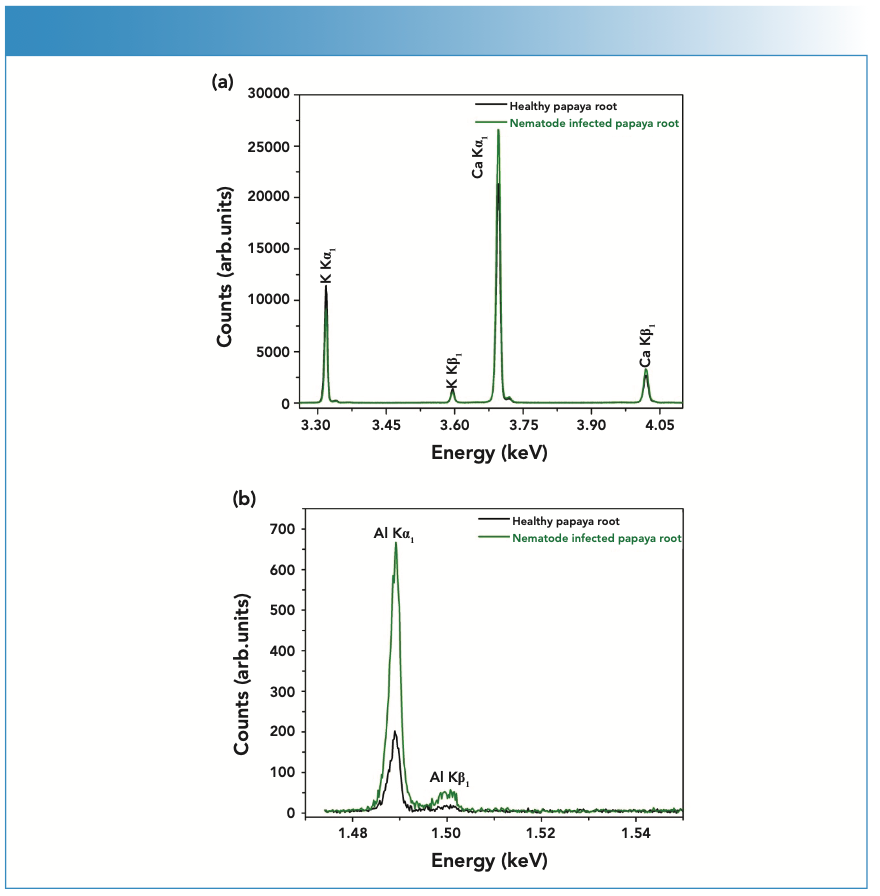
The concentration of silicon was found to be elevated from 0.23 to 0.53% from uninfected to nematode-infected papaya root samples. Sharma and others also observed the same elevated concentration patterns of calcium, magnesium, and silicon while performing elemental and molecular studies of nematode-diseased okra root samples (7). It has been observed that the elements calcium, magnesium, and silicon are the major nutrients that are beneficial in maintaining the outer coating of cell membranes and thereby helping plant cells defend against pathogen invasions. The increasing concentrations of calcium, magnesium, and silicon seen in our findings can be correlated with the induction and activation of defense systems in response to the attack of pathogens. In addition to these elements, we also found increasing concentrations of iron, aluminum, and titanium in papaya plants with the arrival of nematodic infection. The particular role of aluminum and chromium in the physiological and biochemical behavior of plants has not been determined yet.
Macroelements, such as potassium and phosphorus, are essential and play various roles, like activating enzymatic systems, inducing protein synthesis, managing photosynthesis processes, moving stomata, maintaining balance between cations and anions, and transferring energy (8). It has been observed from WDXRF analysis of healthy and diseased papaya root samples that the concentrations of these two macroelements decreased with the arrival of nematodes and fungal infections on papaya plants. It is well reported that potassium and phosphorus encourage the thickening of cell walls and thereby induce barriers that hinder the further movement of the attacking pathogens inside the plant body (8).
Decreasing concentrations of some other elements, such as copper, manganese, sodium, and zinc, were observed in the papaya root samples with the arrival of a nematode attack. Similar results were also reported by Sharma and others. Traces of the elements zirconium and molybdenum were found in the diseased papaya root samples only, also similar to observations made by Sharma and others (7).
The relative concentrations of the elements calcium, magnesium, silicon, potassium, sodium, and iron, are shown in Figure 5. Changes in the concentrations of several of these elements can lead to serious consequences for the health and viability of papaya plants.
FIGURE 5: Relative concentrations of elements in papaya root samples and comparison with LIBS data. Data were taken from reference (8). (a) WDXRF data, and the (b) LIBS data.

We have also validated our experimental findings using laser-induced breakdown spectroscopy (LIBS), as shown in Figure 5. For a LIBS method that is free from self-absorption, it has been observed that the intensity of the elemental characteristic line is more closely related to the concentrations of the sample analytes (8). To confirm that there is no self-absorption in the LIBS method, we have verified all the conditions, such as the existence of stoichiometric ablation, local thermal equilibrium, and optical thickness of the plasma. Furthermore, we have calculated the peak area intensity ratios of certain elements like calcium (393.36 nm), potassium (766.48 nm), magnesium (279.55 nm), sodium (588.99 nm), iron (238.40 nm), and silicon (288.15 nm) from the LIBS results of papaya plant samples. These calculated values were further taken as the concentrations of these elements and directly compared with the concentration values of the WDXRF spectra of papaya plants. Given that LIBS and WDXRF follow different criteria, to compare the results of the techniques, we focused only on the trends we observed for each element in the papaya plant samples, which are clearly indicated in Figure 5.
Figures 5a and 5b show bar graphs of the results obtained using LIBS and WDXRF and reveals the patterns of the concentrations of major elements such as calcium, sodium, iron, magnesium, potassium, and silicon in the diseased and healthy papaya root samples. Because the same trends of the element concentrations were observed by both techniques for the analysis of papaya plant samples, we believe that both techniques can be considered proficient methods for assessing the composition of mineral elements in healthy and diseased plant samples, both qualitatively and quantitatively.
Study of Rice Crop Infected by False Smut Disease
WDXRF spectroscopy was also employed for the spectroscopic investigation of rice grains from rice crops infected with false smut disease. The WDXRF spectra of healthy and diseased rice grains were recorded within different energy ranges. Changes in the elemental composition of the rice grains associated with black and yellow smutty fungal spores on the upper and lower surface of the rice spikelets, were investigated. For the sake of simplicity, we have encoded our samples R1, R2, and R3 on the basis of severity of false smut disease, where R1 stands for uninfected rice grain samples, R2 stands for rice grain samples with low levels of infection, and R3 for highly infested rice grain samples.
Using WDXRF spectroscopy, we have quantified the presence of numerous essential and non-essential elements in rice samples, including calcium, aluminum, copper, iron, chlorine, magnesium, manganese, nickel, phosphorus, chromium, potassium, rubidium, silicon, sulfur, and zinc. Figures 6a and 6b show the overlapping WDXRF spectra for the different rice grain samples, indicating the relative presence of phosphorus, silicon, sulfur, chromium, manganese, iron, nickel, copper, and zinc in the various rice grain samples (R1, R2, and R3). We also verified our results using LIBS. The detailed results of similar studies have been discussed by Sharma and others (9).
FIGURE 6: (a,b) WDXRF spectra for elements in healthy rice grains and in rice grains infected with false smut. Data were taken from reference (9).
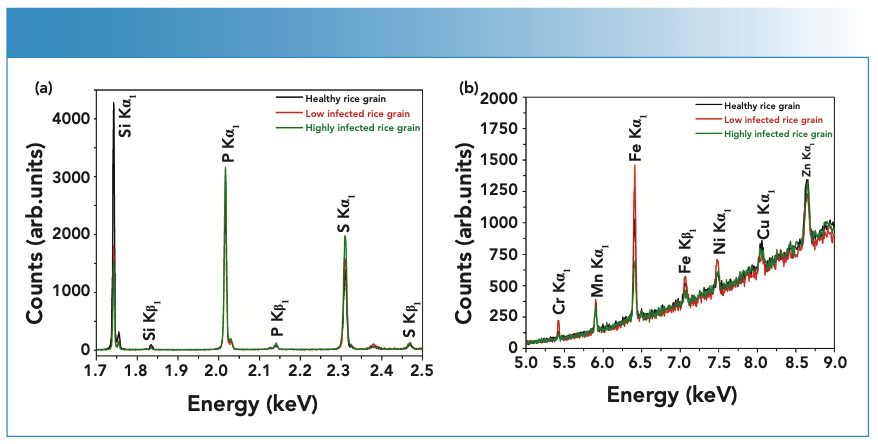
The trends of relative concentrations of mineral nutrients observed using LIBS and WDXRF were similar. Using LIBS and WDXRF, we have observed the pattern for copper, silicon, and calcium as R1 > R2 > R3, whereas for chromium, iron, and magnesium, the trends was R2 > R1 > R3. Some mineral elements, such as potassium and manganese, followed patterns of R3 > R2 > R1 and R2 > R3 > R1. From these studies, it was concluded that the two techniques are complementary to each other and can be used collectively for investigating elemental changes that may take place in the composition of the plant samples with the association of various plant diseases.
As mentioned previously, it is documented in the literature that the induction of some mechanical obstructions, production of anti-oxidant compounds, and triggering of defense systems in the plant body all are correlated with good accessibility of the important mineral nutrients in the plant body (9). In our study, we have observed that some major elements, such as potassium, phosphorus, and sulfur, were present in higher concentrations in the diseased rice grain samples, and it is feasible to relate these increases with the production, induction, and activation of various defense systems that hinder the further movement of the pathogens into the plants body. Sieverding and others have also reported increased concentrations of potassium and phosphorus in corn crop plants following inoculation with Glomus mosseae and Glomus intradices (16). The concentration values of the nutrient element sulfur increased from 0.14 in uninfected rice grains to 0.2% in diseased rice grain samples.
We also noticed significant increases in the concentrations of chlorine and manganese in diseased rice grain samples. The increased level of chlorine can be related with the initiation and activation of defense responses against fungal spores (15). Identical increasing trends were also seen and reported by other researchers (7,17). In one study, where an elevated concentration of manganese was observed in the barley plant samples, the author claimed that such elevation is because of the stimulation of manganese content with the association of microbes present in the rhizosphere of soil (18). The same patterns corresponding to elements such as chlorine, manganese, potassium, phosphorus, nickel, and sulfur has been seen and reported by Singh and others in studies of nematode-infested wheat grains by WDXRF spectroscopy (17).
In our studies, we also observed lower concentrations of aluminum, calcium, copper, iron, magnesium, silicon, and zinc with the infestation of black and yellow smutty fungal spores in rice. The decreased level of magnesium was also seen and reported by Bateman and others while doing investigations of beans from plants infected with the fungus Rhizotonia solani (19). Because major elements such as calcium and magnesium are related with the maintenance of outer cell walls, the decreasing levels of these elements may be associated with the weakening and diminishing of cell walls, leading to escape of sugars and amino acids from plant tissues and thereby attracting the attention of several fungal species. Imbalances in the contents of the macroelements such as calcium, potassium, and magnesium, were also reported with the occurrence of green stem and foliar retention (GSFR) disease on the plant samples (9).
Rice plants are well-known for their capacity to accumulate high levels of silicon from the soil (20). In our findings, we noticed a decrease in the content of silicon with the association of smutty balls in the rice crop plant. The content of silicon falls from 1.27% in uninfected rice grains to 0.45% in diseased rice grain samples with the occurrence of fungal disease. The role of silicon is similar to that of calcium and magnesium: It is known for maintaining the strength of the outer cell walls, so a decreased level of silicon indicates the diminishing of the outer layer of cell walls (21).
We also saw lower concentrations of aluminum, copper, iron, and zinc in diseased rice grain samples with the arrival of fungal diseases on rice crop plants. The particular role of aluminum and chromium elements in the physiological and biological behavior of plants has not been determined yet. In our findings, we have observed that the level of aluminum decreases from 0.03 to 0.01% with the occurrence of fungal disease in rice crop plants.
The element chromium is known for its toxicity and causes various detrimental effects on the physiological behavior of a plant system, such as disturbing the uptake capacity of mineral nutrients and water intake, inducing oxidative stresses, interfering the photosynthesis mechanism, and causing plant cell death (9). These toxic effects of chromium begin with the association of 0.0005% of chromium in the agronomic plants (9). The concentration of chromium in our results rose from 0.0011 in uninfected rice grains to 0.0046% in rice grain samples infected with fungal disease. Similar results for chromium were observed by Singh and others (17) in spectroscopic investigations of nematode- and fungal-infested wheat seeds and by Sharma and others (7) in nematode- and fungal-infested okra root samples.
It is well-documented in the literature that the pathogens started developing strategies to minimize its defense systems and make them totally depriving of basic nutrients after intruding the host body whereas the host body in response makes some changes in its internal composition to restrict further movement of the pathogens into the plant body (9). Thus, the decreasing and increasing contents of some nutrient elements with the occurrence of smutty fungal spores on the surface of rice spikelets due to the arrival of false smut disease can be considered the consequences and responses of the host body with the attack of pathogens.
In conclusion, we present a summary of the plant species, disease, and elements detected in healthy and diseased plant samples in Table I. Elements whose concentrations increased and decreased because of the disease are listed in Table I. Table I indicates the observable changes in the concentrations of elements, related to the diseases that occurred in the plant samples.
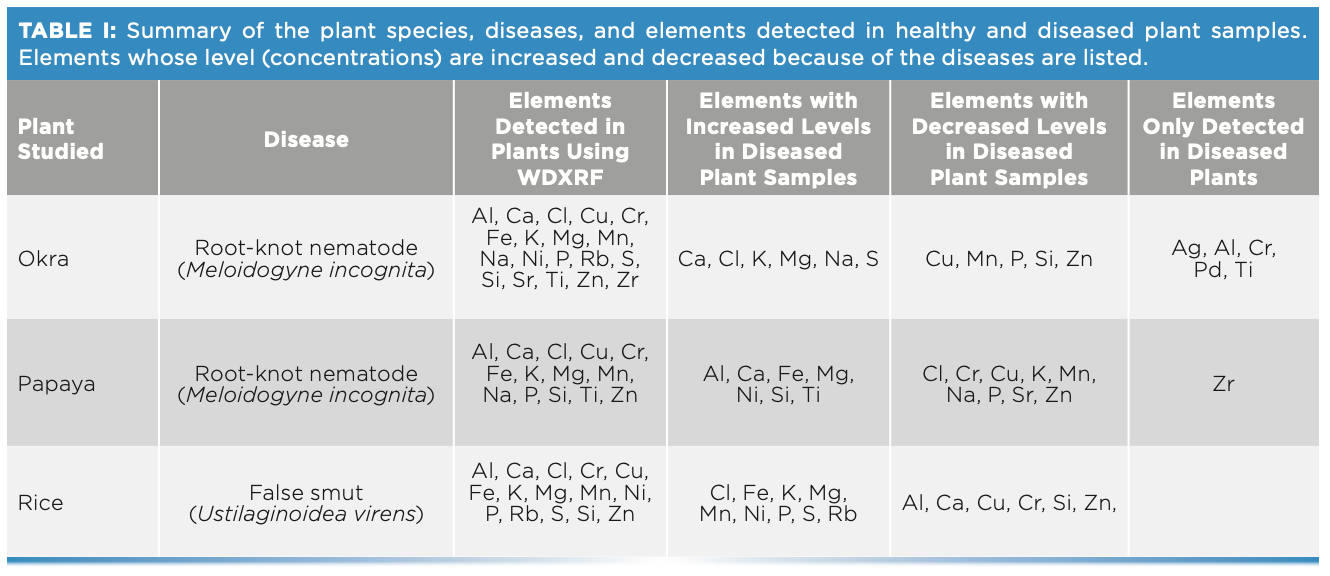
Conclusion and Further Research
In the present work, we explored potential applications of WDXRF for analyzing important agricultural crops, which provided valuable information regarding their elemental composition. This information is then used to characterize their behavior after infestation by plant diseases such as nematodes and false smut disease.
However, elemental imaging techniques, such as scanning electron microscopy (SEM) with energy dispersive X-ray analysis (EDX), field emission (FE)-SEM, and micro-XRF, would provide additional information regarding the role of heavy and toxic elements in these plant diseases. These methods would enable a useful visualization and mapping of the distribution of organic matter as well as the changes in the mineral elements on a micrometer scale. Also, more exhaustive work on the multivariate analysis of WDXRF data will provide more information related to these kinds of diseases (nematodes, false smut and other bacterial and fungal diseases) in agricultural crops.
Acknowledgment
Ms. Neha Sharma (Senior Research Fellow, SRF) is thankful to DST, Government of India for INSPIRE Fellowship (IF160893). Author Vivek K. Singh is thankful to Shri Mata Vaishno Devi University, India, for all kinds of support to carry out this research.
References
(1) B.C. Bennett, Encyclopaedia of Life Support Systems (EOLSS), 30–34 (1998).
(2) L. Trevizan, D. Santos, R. Samad, N. Vieira, C. Nomura, L. Nunes, L. Rufini, and F. Krug, Spectrochim. Acta B. 63, 1151–1158 (2008).
(3) G. Dalcorso, A.Manara, S. Piasentin, and A. Furini, Metallom. 6, 1770–1788 (2014).
(4) E. Margui, M. Hidalgo, and I. Queralt, Spectrosc. Eur. 19, 13–17 (2007).
(5) J.B. Godey, Laboratory Methods for Work with Soil and Plant Nematodes (Technical Bulletin Ministry of Agriculture, London, United Kingdom, 1963).
(6) J.D. Eisenback, Biol. Control. 1, 95–122 (1985).
(7) N. Sharma, Y. Khajuria, J. Sharma, D.K. Tripathi, D.K. Chauhan, V.K. Singh, V. Kumar, and V.K. Singh, Vacuum 158, 126–135 (2018).
(8) N. Sharma, Y. Khajuria, V.K. Singh, S. Kumar, Y. Lee, P.K. Rai, and V.K. Singh, At. Spectrosc. 41, 110–118 (2020).
(9) N. Sharma, Kamni, V.K. Singh, S. Kumar, Y. Lee, P.K. Rai, and V.K. Singh, Appl. Phys. B. 126, 122 (2020).
(10) A.A. Farahat, A. Al-Sayed, and N.A. Mahfoud, Egypt. J. Agronematol. 12, 139–158 (2013).
(11) W. Sharma and P.C. Trivedi, Ind. J. Nematol. 26, 152–157 (1996).
(12) H. Brhane, E. Fikru, T. Haileselassie, and K. Tesfaye, African J. Agric. Res. 12, 1144–1148 (2017).
(13) L. Reale, F. Ferranti, S. Mantilacci, M. Corboli, S. Aversa, F. Landucci, C. Baldisserotto, L. Ferroni, S. Pancaldi, and R. Venanzoni, Chemosph. 145, 98–105 (2016).
(14) I. UdDin, A. Bano, and S. Masood, Ecotoxicol. Env. Safety. 113, 271–278 (2014).
(15) C. Dordas, Agron. Sustain. Dev. 28, 33–46 (2008).
(16) E. Sieverding, G.A. Silva, R. Berndt, and F. Oehl, Mycotax. 129, 373–386 (2014).
(17) V.K. Singh, A. Devi, S. Pathania, V. Kumar, D.K. Tripathi, S. Sharma, D.K. Chauhan, et al, Biocatal. Agric. Biotechnol. 9, 58–66 (2017).
(18) D.A. Barber and R.B. Lee, New Phytol. 76, 69–80 (1974).
(19) D.F. Bateman, Phytopathol. 54, 438–445 (1964).
(20) E. Takahashi, J.F. Ma, and Y. Miyake, J. Agric. Food Chem. 2, 99–102 (1990).
(21) D. Bhaduri, R. Rakshit, and K. Chakraborty, Int. J. Bio-Res Stress Man. 5, 461–466 (2014).
Vivek K. Singh and Neha Sharma are with the School of Physics at Shri Mata Vaishno Devi University, in Katra, India. Virendra K. Singh is with the Department of Plant Pathology in the College of Agriculture at Banda University of Agriculture and Technology, in Banda, Uttar Pradesh, India. Direct correspondence to: vivekksingh2005@gmail.com ●

AI Shakes Up Spectroscopy as New Tools Reveal the Secret Life of Molecules
April 14th 2025A leading-edge review led by researchers at Oak Ridge National Laboratory and MIT explores how artificial intelligence is revolutionizing the study of molecular vibrations and phonon dynamics. From infrared and Raman spectroscopy to neutron and X-ray scattering, AI is transforming how scientists interpret vibrational spectra and predict material behaviors.
Advancing Corrosion Resistance in Additively Manufactured Titanium Alloys Through Heat Treatment
April 7th 2025Researchers have demonstrated that heat treatment significantly enhances the corrosion resistance of additively manufactured TC4 titanium alloy by transforming its microstructure, offering valuable insights for aerospace applications.